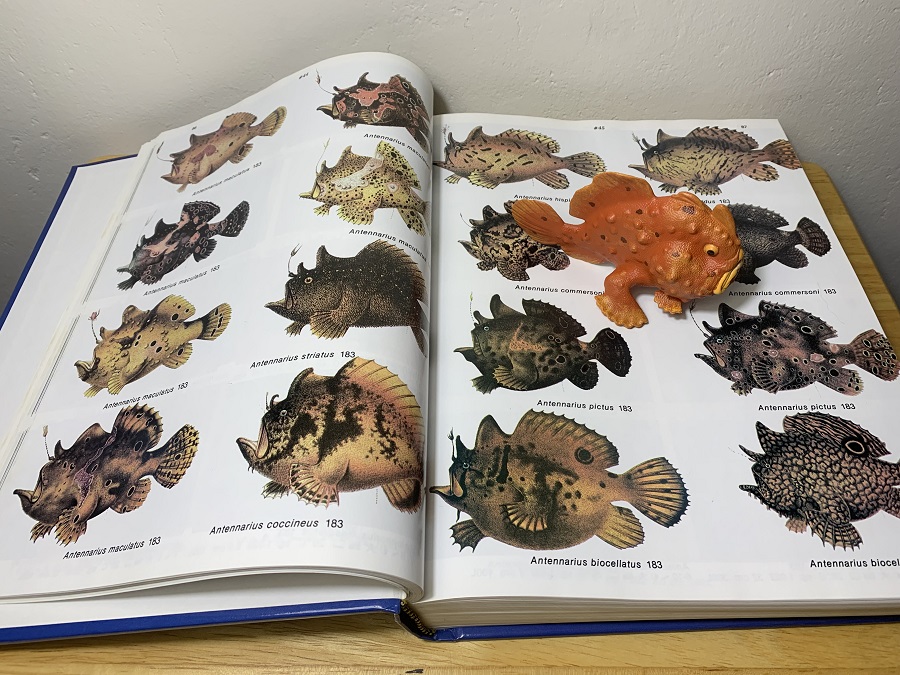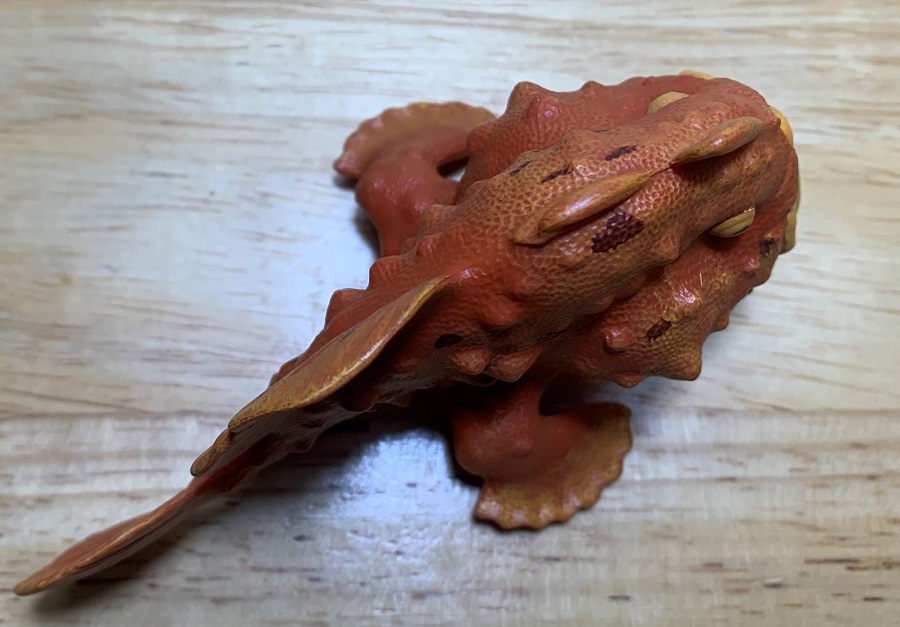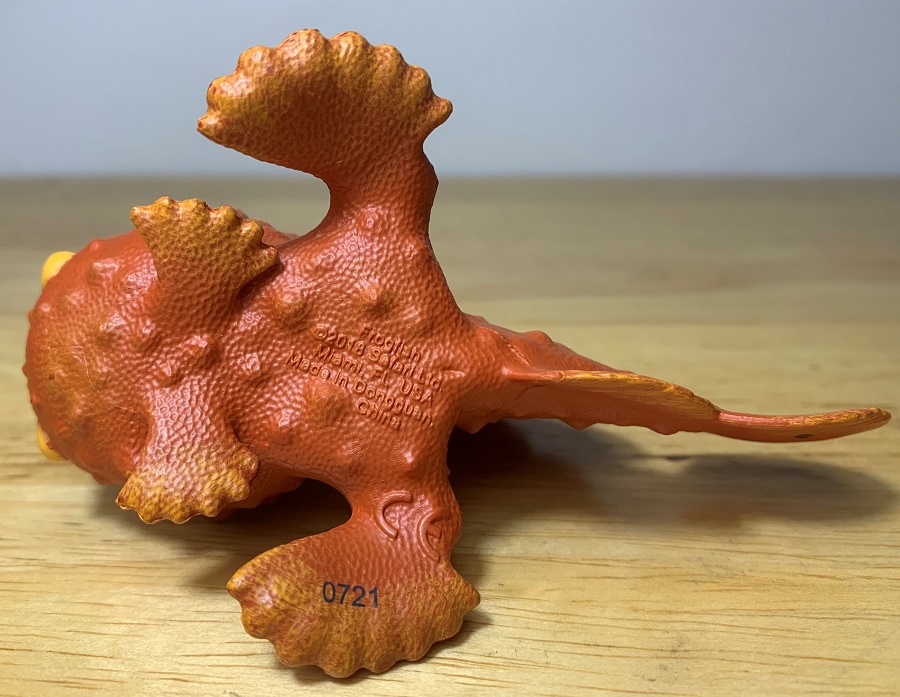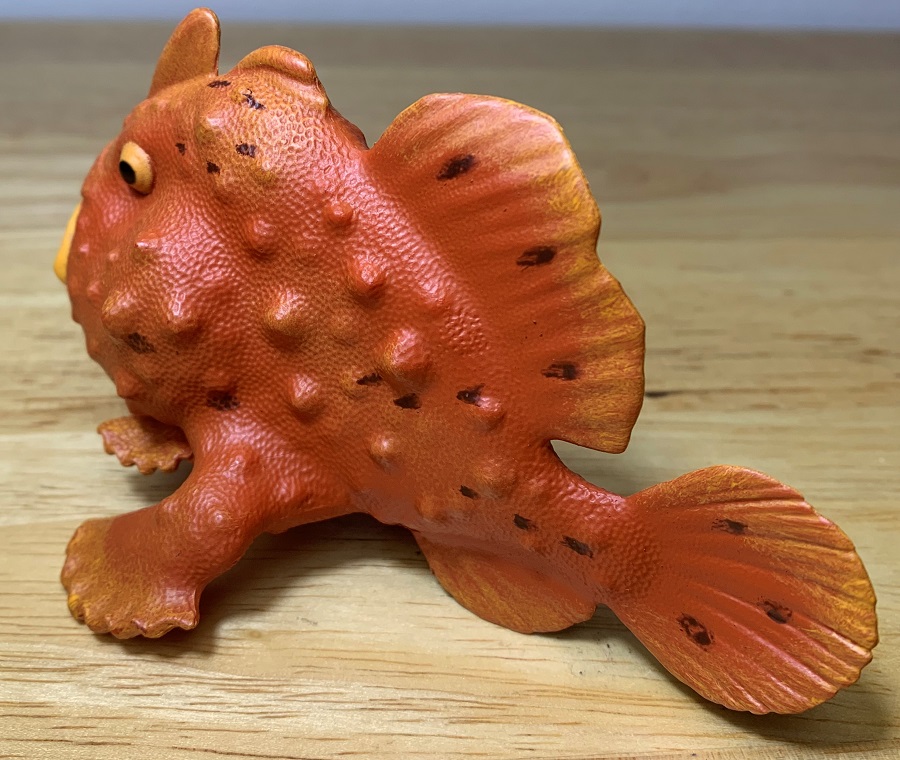With its stout body, limb-like fins, large head, and perpetual frown, it is easy to see how the frogfish got its name. Frogfishes are members of the anglerfish family, Antennariidae. There are about 50 species of them, and they can be found in almost all tropical and subtropical waters around the world where they inhabit coral reefs and rocky habitats. Frogfishes are masters of camouflage and stealth. Their shape, color, and skin texture often mimics the coral reefs, sponges, rocks and other structures where they live. Some frogfishes are even covered in algae or hydrozoa, making their disguises that much more convincing. Frogfishes are ambush predators, and like other anglerfish use a lure to attract their prey. Once within range the frogfish is capable of striking at and capturing its prey in as little as 6 milliseconds.

Today we’re reviewing the Safari 2018 frogfish. The first order of the day however is to identify it. Safari only markets the figure as a frogfish and on the web site they only identify it at the family level. Narrowing it down to the genus is fairly easy and in doing so it appears that this figure belongs to the Antennarius genus, which contains 11 species. Frogfishes can be confidently identified by their illicium (rod) and esca (lure) which are modified dorsal fin rays. But those are not sculpted on this toy, so we can’t go that route. Since color is so variable in frogfish species, we can’t use that to identify the figure either. But the presence of numerous ocelli (which mimic sponge holes) help to identify this figure as a painted frogfish (Antennarius pictus) and differentiate it from similar species within its genus.

Painted frogfish live in coral and rocky reefs up to 246’ (75 meters) deep. They can be found throughout the Indo-Pacific, including in the Red Sea. Painted frogfish can reach a length of 12” (30 cm). The Safari frogfish measures 4.5” (11.43 cm) long and stands about 2.75” (6.985 cm) tall. This puts it at about 1/2.6 in scale.

The Safari frogfish is delightfully textured with its warty protuberances and stippling across the sculpt that resemble the dermal spinules of the actual frogfish. Frogfishes do not have scales. The large mouth is detailed with creases along its edges and teeth slightly visible within. One center tooth can be seen on the upper jaw and five in the lower. The stout and robust pectoral and pelvic fins do indeed resemble frog feet and in life frogfishes rarely swim, preferring to use their fins to clamber across the seabed.

The dorsal fin is divided up into three distinct portions with noticeable gaps between them and even the number of rays appears correct, 3 spiny and 12-13 soft. As mentioned, the rod and lure are missing. Since it is a toy, its absence here is excusable. In order to sculpt it without fear of breakage the rod would have to be much thicker than in life and would look ridiculous. Still, I think Safari could have at least sculpted it laying across the back or something.


The figure is painted in mottled orange tones with black ocelli on the body and on the dorsal and caudal fins. The eyes and mouth are light orange and the eyes are painted with shiny black pupils. The teeth are white. The paint application across the figure is superb. In life the painted frogfish can be white, black, cream, pink, yellow, red, or brown. Individual fish can change their color and pattern to match their environment within a few weeks.


The Safari painted frogfish is so lifelike in execution that I believe you could stick it in an aquarium, tell people it’s alive, and they would believe you. Especially since the species seldom moves. I absolutely adore this figure and consider it a highlight in my collection. Another incredible figure in Safari’s Incredible Creatures line. The Safari frogfish is widely available and retails for about $10.00.


Disclaimer: links to Ebay and Amazon on the AnimalToyBlog are affiliate links, so we make a small commission if you use them. Thanks for supporting us!




This is a figure I have always been tempted to get, but feared it was too large, especially compared with the other two species of Antennarius I have.
But now that I see a review of it I must re-think my decision. Gwangi you have officially become my fish-whisperer, after the Marsh Education set, the IC Goliath Grouper and how this 😀
Haha, that’s awesome. I think when it comes to fish I just don’t care about scale, there aren’t enough fish figures for me to be that picky and figures like this are just too good. My next review is for a fish too but it’s not exactly a positive one, so I think you’re safe.
yeah, I am becoming less scale-conscious, especially for smaller species!
at first I didn’t care too much, largely from being spoilt from Japanese brands but after seeing your review on how good the figure is, I’m sorely tempted to add it to my wishlist as a prop!
What book did you use to identify the frogfish?
I used a couple different sources but the book in the picture is Dr. Burgess’s Atlas of Marine Aquarium Fishes.